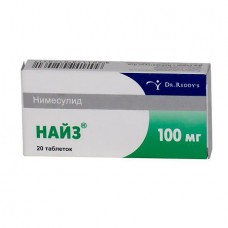Expiration date: 01/2026
Composition:
Each tablet contains:
Active substance: nimesulide 100 mg.
Excipients: calcium hydrophosphate 75 mg, microcrystalline cellulose (type
114) 40 mg, corn starch 54 mg, sodium carboxymethyl starch 35 mg, magnesium stearate 3 mg,
silicon dioxide colloidal 2 mg, talc 1 mg.
Description
White with a yellowish tinge round biconvex tablets with a smooth surface.
Pharmacotherapy group: non-steroidal anti-inflammatory drug (NSAID).
ATX code: M01AH17.
Pharmacological properties
Pharmacodynamics
Nonsteroidal anti-inflammatory drug (NSAID) from the class of sulfonanilides. Is
selective competitive inhibitor of cyclooxygenase-2 (COX-2), inhibits the synthesis of prostaglandins in the focus of inflammation. The depressing effect on COX-1 is less pronounced (less often causes side effects associated with inhibition of prostaglandin synthesis in healthy tissues). It has anti-inflammatory, analgesic and pronounced antipyretic effect
action.
Pharmacokinetics
Oral absorption is high (food intake reduces the rate of absorption without affecting its degree). The time to reach the maximum concentration (TCmax) is 1.5 – 2.5 hours. The relationship with plasma proteins is 95%, with red Blood cells-2%, with lipoproteins – 1%, with acidic alpha1 – glycoproteins – 1%. Changing the dose does not affect the degree of binding. The maximum concentration (Cmax) is 3.5 – 6.5 mg/l. The volume of distribution is 0.19 – 0.35 l/kg. Penetrates into the tissues of the female genital organs, where after a single dose, its concentration is about 40% of the concentration in plasma. It penetrates well into the acidic environment of the focus of inflammation (40%), synovial fluid (43%). Easily permeates through gistogematicalkie barriers.
It is metabolized in the liver by tissue monooxygenases. The main metabolite, 4-hydroxynimesulide (25%), has similar pharmacological activity, but due to a decrease in the size of the molecules, it can quickly diffuse along the hydrophobic COX-2 channel to the active binding center of the methyl group. 4-hydroxynimesulide is a water-soluble compound that does not require glutathione and phase II conjugation reactions (sulfation, glucuronidation, and others).
The half – life (T1/2) of nimesulide is 1.56-4.95 hours, 4-hydroxynimesulide is 2.89 – 4.78 hours.
4-hydroxynimesulide is excreted by the kidneys (65%) and with bile (35%), and undergoes enterohepatic recirculation.
In patients with renal insufficiency (creatinine clearance 1.8-4.8 l/h or 30-80 ml/min), as well as in children and the elderly, the pharmacokinetic profile of nimesulide does not change significantly.
Indications for use
- rheumatoid arthritis,
- joint syndrome with acute gout,
- psoriatic arthritis,
- ankylosing spondylitis,
- osteochondrosis with radicular syndrome,
- osteoarthritis,
- myalgia of rheumatic and non-rheumatic origin,
- inflammation of ligaments, tendons, bursitis, including post-traumatic soft tissue inflammation,
- pain syndrome of various origins (including in the postoperative period, with injuries, algodismenorrhea, toothache, headache, arthralgia, lumboishalgia).
The drug is intended for symptomatic therapy, reducing pain and inflammation at the time of use, and does not affect the progression of the disease.
Contraindications
Hypersensitivity to the active substance or auxiliary components, complete or incomplete combination of bronchial asthma, recurrent nasal or paranasal polyposis and intolerance to acetylsalicylic acid and other NSAIDs (including in the anamnesis), erosive and ulcerative changes in the gastric and duodenal mucosa (duodenum), active gastrointestinal bleeding, cerebrovascular or other bleeding, inflammatory bowel diseases (Crohn's disease, ulcerative colitis) in the acute phase, hemophilia and other blood clotting disorders, decompensated heart failure, liver failure or any active liver disease, anamnestic data on the development of hepatotoxic reactions when using nimesulide preparations, concomitant use of potentially hepatotoxic substances, alcoholism, drug addiction, severe renal failure (creatinine clearance less than 30 ml/min), progressive kidney disease, confirmed hyperkalemia, the period after coronary artery bypass grafting, pregnancy, lactation, children under 12 years of age (for this dosage form see section "Special instructions").
With caution
Coronary heart disease, cerebrovascular diseases, congestive heart failure, dyslipidemia/hyperlipidemia, diabetes mellitus, peripheral artery disease, Smoking, creatinine clearance less than 60 ml/min. Anamnestic data about the development of ulcerative shock syndrome, infection of Helicobacter pylori, older age, prolonged use of NSAIDs, frequent use of alcohol, serious somatic diseases, concomitant therapy with anticoagulants (eg, warfarin), an antiplatelet agents (e.g. acetylsalicylic acid, clopidogrel), oral corticosteroids (eg, prednisolone), selective inhibitors of reverse takeover serotonin (e.g., citalopram, fluoxetine, paroxetine, sertraline).
Dosage and administration
The minimum effective dose should be used in the shortest possible course. Tablets are taken with a sufficient amount of water, preferably after a meal.
Adults and children over 12 years of age – inside 1 tablet 2 times a day. In the presence of diseases of the gastrointestinal tract, it is advisable to take the drug at the end of a meal or after a meal. The maximum daily dose for adults is 200 mg.
Patients with chronic renal failure need to reduce the daily dose to 100 mg.
Side effect
The frequency of side effects is classified according to the frequency of occurrence of the case: often (1-10%), sometimes (0.1-1%), rarely (0.01-0.1%), very rarely (less than 0.01%), including individual reports.
Allergic reactions: rarely – hypersensitivity reactions, very rarely – anaphylactoid reactions.
From the Central nervous system: infrequently – dizziness, rarely – a feeling of fear, nervousness, nightmares, very rarely – headache, drowsiness, encephalopathy (Reye's syndrome).
From the skin: infrequently – itching, rash, increased sweating, rarely: erythema, dermatitis, very rarely: urticaria, angioedema, facial edema, multiform exudative erythema, including Stevens-Johnson syndrome, toxic epidermal necrolysis (Lyell's syndrome).
From the urinary system: infrequently – edema, rarely – dysuria, hematuria, urinary retention, hyperkalemia, very rarely – renal failure, oliguria, interstitial nephritis.
From the gastrointestinal tract: often – diarrhea, nausea, vomiting, infrequently – constipation, flatulence, gastritis, very rarely – abdominal pain, stomatitis, tarry stools, gastrointestinal bleeding, ulcers and/or perforation of the stomach or duodenum.
From the liver and biliary system: often – increased "hepatic" transaminases, very rarely – hepatitis, lightning hepatitis, jaundice, cholestasis.
From the hematopoietic organs: rarely – anemia, eosinophilia, very rarely – thrombocytopenia, pancytopenia, purpura, prolonged bleeding time.
From the respiratory system: infrequently – shortness of breath, very rarely – exacerbation of bronchial asthma, bronchospasm.
From the sensory organs: rarely – blurred vision.
From the cardiovascular system: infrequently – arterial hypertension, rarely – tachycardia, hemorrhages, "hot flashes".
Other: rarely – General weakness, very rarely – hypothermia.
Overdose
Symptoms: apathy, drowsiness, nausea, vomiting. Gastrointestinal bleeding, increased blood pressure, acute renal failure, and respiratory depression may occur.
Treatment: the patient needs symptomatic treatment and supportive care. There is no specific antidote. If an overdose has occurred within the last 4 hours, it is necessary to induce vomiting, provide activated carbon (60-100 g per adult), osmotic laxatives. Forced diuresis and hemodialysis are ineffective due to the high binding of the drug to proteins.
Interaction with other medicinal products
The effect of medications that reduce blood clotting is enhanced when they are used simultaneously with nimesulide.
Nimesulide may reduce the effect of furosemide. Nimesulide may increase the possibility of side effects while taking methotrexate.
The level of lithium in the plasma increases with simultaneous administration of lithium and nimesulide.
Nimesulide may increase the effect of cyclosporine on the kidneys.
Use with glucocorticosteroids, serotonin reuptake inhibitors increases the risk of gastrointestinal bleeding.
Special instruction
Since Nise® is partially excreted by the kidneys, its dose for patients with impaired renal function should be reduced, depending on creatinine clearance indicators.
Given reports of visual impairment in patients who have taken other NSAIDs, treatment should be stopped immediately if any visual impairment occurs and the patient should be examined by an optometrist.
The drug may cause fluid retention in the tissues, so patients with high blood pressure and heart disorders should use Nise® with extreme caution.
Patients should undergo regular medical monitoring if they are taking medications along with nimesulide that have a characteristic effect on the gastrointestinal tract.
When signs of liver damage appear (itching, yellowing of the skin, nausea, vomiting, abdominal pain, darkening of the urine, increased levels of "liver" transaminases) you should stop taking the drug and consult your doctor.
Do not use the drug simultaneously with other NSAIDs.
The drug can change the properties of platelets, but does not replace the preventive effect of acetylsalicylic acid in cardiovascular diseases.
The use of the drug may negatively affect female fertility and is not recommended for women planning pregnancy.
After 2 weeks of use of the drug, it is necessary to monitor the biochemical parameters of liver function.
This dosage form is contraindicated for children under 12 years of age, but if it is necessary to use nimesulide in children over 7 years of age, 50 mg dispersible tablets and suspension can be used in strict accordance with the instructions for medical use attached to them.
Since the drug can cause drowsiness, dizziness and blurred vision, caution should be exercised when driving vehicles and engaging in other potentially dangerous activities that require increased concentration and speed of psychomotor reactions.
Form release
Tablets 100 mg.
1, 2, 3 or 10 PVC/aluminum blisters of 10 tablets together with the instructions for use are Packed in a cardboard pack.
Storage conditions
In a place protected from light at a temperature not exceeding 25 °C.
Keep out of reach of children!
Expiration date
3 years.
Do not use after the expiration date indicated on the package.
Nise
(Nimesulide)
tablets
- Brand: Dr.Reddy's



